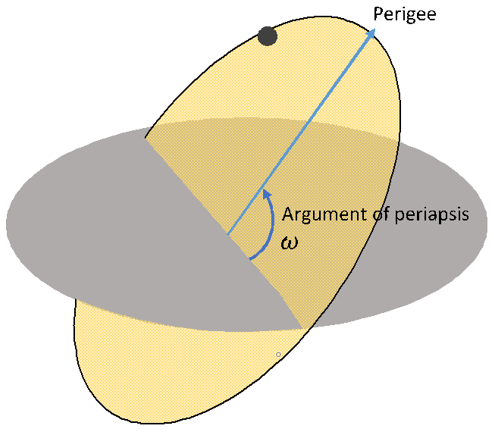This set of Spaceflight Mechanics Multiple Choice Questions & Answers (MCQs) focuses on “Moon’s Orbital Elements”.
1. How many orbital elements are used to describe the moon?
a) 2
b) 3
c) 4
d) 6
View Answer
Explanation: Just like Earth, even moon has orbital elements used to describe the orbit and the position. The moon’s orbit is defined by six orbital elements as follows: semi-major axis (a), eccentricity (e), inclination (i), longitude of the ascending node (Ω), right ascension at epoch (α) and the argument of perigee (ω).
2. Which of these orbital elements determines the size of the lunar orbit?
a) Eccentricity
b) Semi-major axis
c) Inclination
d) Argument of periapsis
View Answer
Explanation: The six orbital elements are used to describe the shape, size and orientation. The semi-major axis (a) is used to determine the size of the orbit. Eccentricity is is determine the orbit shape, and the argument of periapsis determines the orbit’s orientation.
3. Which of these orbital elements determines the shape of the lunar orbit?
a) Eccentricity
b) Semi- major axis
c) Inclination
d) Argument of periapsis
View Answer
Explanation: The six orbital elements are used to describe the shape, size and orientation. The shape of the orbital element is determined using the eccentricity. This defines the shape of the conic orbit. It is determined using the formula:
e2 = \(\frac{r_A – r_B}{r_A + r_B}\)
Where, rA and rB are the radius of apogee and perigee of lunar orbit.
4. What does the Argument of perigee help in determining?
a) Orbit’s plane’s rotation about the Earth
b) Orbit’s shape
c) Satellite’s location in the orbit
d) Orbit’s orientation in the orbital plane
View Answer
Explanation: Argument of perigee is the angle measured in the direction of satellite motion, from the ascending node to the periapsis. The value varies from 0° to 360° and it is undetermined when i = 0° or 180° or when the eccentricity is zero (i.e.,for circular orbits).

5. What is the angle between vernal equinox and to the ascending node called?
a) Longitude of ascending node
b) Semi-major axis
c) Right ascension at epoch
d) Argument of periapsis
View Answer
Explanation: Longitude of ascending node is known as the angle in the fundamental plane between the vernal equinox and the point where satellite crosses through the fundamental plane in northerly direction (ascending node. That is why it is also known as right ascension of ascending node. It is measured counter clockwise when it is viewed from the north side of the fundamental plane.
6. The orbital elements of the Moon are constant.
a) True
b) False
View Answer
Explanation: Unlike earth’s orbit, moon’s orbit is perturbed due to third-body (Sun) effect. This leads to the orbital elements constantly changing with time. These perturbations are caused due to sun’s gravitational pull. The orbital elements at a particular time is determined from lunar ephemeris published in American Ephemeris and Nautical Almanac.
7. What is the term used for the variation in the Moon’s eccentricity due to perturbations?
a) Evection
b) Lunar perturbation
c) Flutter
d) Variation
View Answer
Explanation:The moon’s orbit is perturbed due to the effect of Sun’s gravitational pull. This results in small period changes in the orbital eccentricity at intervals of 31.8 days. This effect is known as evection which was discovered by Hipparchus.
8. At what mean angle is the moon’s orbit inclined to the ecliptic plane?
a) 4° 3′
b) 5° 8′
c) 5° 3′
d) 6° 2′
View Answer
Explanation: Ecliptic plane is the hypothetical plane of earth’s revolution around the sun. The moon’s orbit is inclined to this ecliptic plane at an angle of 5° 8′. The line of nodes i.e. the intersection point of the moon’s orbital plane and ecliptic plane rotates westward completing one orbit in 18.6 years.
9. At which position of the moon does the eclipse occur?
a) When moon is at either side of the equator
b) When moon is at the nodal crossing
c) When moon is at periapsis
d) When moon is at apoapsis
View Answer
Explanation: When the moon is at the either nodal crossing point eclipse occurs. The node where the moon moves from south to north is called ascending node and the node where the moon moves from north to south is known as descending node. Eclipse occurs only a these two points because only in this case the sun, moon and earth are aligned.
10. How long does it take for the line of apsides of the moon’s orbit to rotate by 360 deg?
a) 7 years
b) 8 years
c) 8.9 years
d) 9.4 years
View Answer
Explanation: The line joining the perigee and apogee of the orbit is known as line of apsides. This rotates in the direction of moon’s orbital motion causing argument of perigee to vary by 30 deg in 8.9 years.
11. What is draconitic period?
a) Time taken for the moon to complete one orbit
b) Time between two consecutive eclipse
c) Time taken for moon to go around orbit from one node to another
d) Time taken to complete half orbit
View Answer
Explanation: The time taken for moon to travel from one node in the orbit to another is known as draconitic period or nodal period. Draconitic period is 27.21222 days which is lesser than the sidereal month.
Sanfoundry Global Education & Learning Series – Spaceflight Mechanics.
To practice all areas of Spaceflight Mechanics, here is complete set of 1000+ Multiple Choice Questions and Answers.
If you find a mistake in question / option / answer, kindly take a screenshot and email to [email protected]
